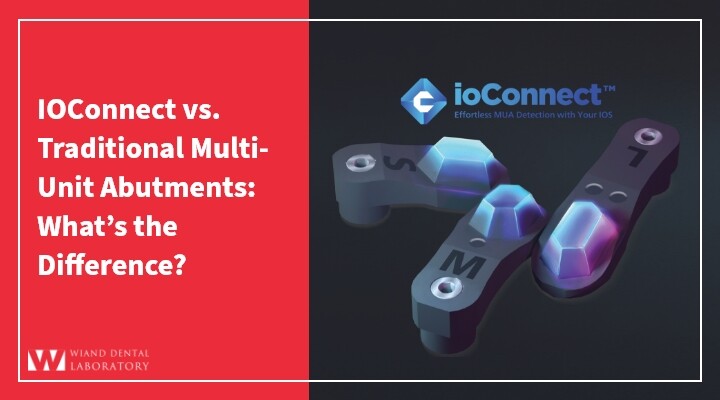
IOConnect vs. Traditional: What’s the Difference?
ioConnect vs. Traditional Multi-Unit Abutments: What’s the Difference?
In implant dentistry, precision and efficiency are everything. Whether you’re restoring a full-arch case or placing a single-unit restoration, the quality of your abutment system can dramatically influence clinical outcomes and long-term patient satisfaction. With the rise of digital workflows and demand for simplified procedures, many clinicians and dental labs are re-evaluating the tools they use—particularly when it comes to the choice between ioConnect and traditional multi-unit abutments.
Let’s break down the differences between ioConnect vs. Traditional Multi-Unit Abutments and help you determine which system is best suited for your clinical needs.
1. Connection Design and Stability
Traditional multi-unit abutments rely on a platform connection that often includes a series of components—base, screws, and coping—that must be assembled with exact torque values and angles. While they offer decent flexibility, the design can be prone to micro-movement if not perfectly seated, especially in complex cases or challenging angulations.
ioConnect, on the other hand, is engineered with a more secure connection interface. Its one-piece design reduces the potential for component loosening, while offering enhanced rotational stability. This results in better long-term predictability, particularly in full-arch and immediate-load scenarios.
2. Ease of Use and Chairside Efficiency
Multi-unit abutments typically require multiple steps: selecting the correct angle and collar height, torquing in place, verifying fit, then selecting and modifying copings. Each of these steps adds time and room for error, especially if components need to be reordered.
ioConnect streamlines the workflow. With fewer parts and an intuitive seating process, clinicians and assistants can save valuable chairside time. The built-in screw access and angulated channel options also make it easier to achieve ideal esthetics without compromising structural integrity.
3. Angulation Flexibility
One of the biggest advantages of ioConnect is its wide range of angulated options. For cases where implants are placed at challenging angles—such as zygomatic or posterior sites—ioConnect offers 0°, 17°, and 30° angulated abutments to correct trajectory without the need for custom milling or remakes.
While traditional multi-units offer similar angles, they typically require the clinician to stock a larger inventory and navigate more complex seating dynamics, especially in tight interarch spaces.
4. Digital Compatibility
Today’s restorative dentistry increasingly relies on CAD/CAM workflows and intraoral scanning. ioConnect was developed with digital integration in mind, offering compatible scan bodies and validated CAD libraries that plug seamlessly into most design software.
Traditional multi-unit systems often require physical impressions or customized scan strategies, which can slow down your digital workflow or lead to inaccurate data capture if the components aren’t fully compatible.
5. Cost and Inventory Management
Because multi-unit systems require a variety of separate parts—including various base heights, copings, and screws—practices often need to maintain a large and costly inventory. This also increases the risk of using incorrect or mismatched components.
ioConnect simplifies inventory by reducing the number of components required per case. With a more universal fit and integrated design, dental labs and clinicians alike can enjoy cost savings and fewer stock-related headaches.
Final Thoughts
While both ioConnect and traditional multi-unit abutments serve an important role in restorative implant dentistry, the trend is clearly shifting toward streamlined, digitally friendly systems like ioConnect. For clinicians and labs focused on improving accuracy, reducing chair time, and embracing digital workflows, ioConnect represents a smart and future-ready choice.
Ready to Upgrade Your Workflow?
At Wiand Dental Lab, we specialize in helping practices transition smoothly to advanced systems like ioConnect. Our expert team provides hands-on support, custom case planning, and digital integration assistance to ensure your success from scan to seat.
Contact Wiand Lab today to learn how ioConnect can transform your restorations and elevate your implant workflow.
